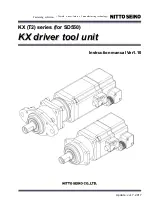
II K 4-22
Overview of Software
4.3 Digital and analogue Inputs/Outputs
Digital inputs DI1…DI8
The drive is controlled via the digital inputs DI1…DI8.
The significance of the inputs are defined by a macro.
When you select a macro in the Macro Select (2.01)
parameter the functions are assigned to the 8 digital
inputs. The functions are described in the context of
respective macros in section
4.2 Application Macros.
The functions of the digital inputs DI1...DI4 of macros
1, 5, 6, 7 and 8 are re-configurable via parameter
group 9.
Digital outputs DO1…DO5
Any signal of a signal list can be assigned to each
digital output. The list is available in the parameters of
the digital outputs DO1…DO5 (DO1 Assign
(6.11)…DO5 Assign (6.15)). The significance and/or
mode of operation of the signals is described there.
The outputs are connected with the application macro
by default i.e. changing the macro will change the
significance of the outputs. The linking of the macro
will be revoked if you allocate another signal. Then the
output will keep its significance even if the setting of
the macro changes.
Analog inputs AI1…AI2 (11 Bits + sign)
The analog inputs are 10V inputs. Offset voltages for
0% and 100% reference can be entered into the
scaling parameters 6.01…6.04:
e.g.:
A reference value is preset by means of a
potentiometer. The zero position of the potentiometer
is not exactly 0V but 0.8V and the full-scale deflection
is not exactly 10V but 9.3 V. Enter 9.30 V into
parameter AIx Scale 100 % (6.01 / 6.03) and 0.80V
into parameter AIx Scale 0 % (6.02 / 6.04). The range
between 0.80V and 9.30V is then considered to be the
100% reference value.
Analog outputs AO1…AO2 (11 Bits + sign)
Any actual value of an actual value list can be as-
signed to the analog outputs. The list is available in
the AOx Assign parameters (6.05 / 6.08). The outputs
are connected with the application macro by default
i.e. changing the macro will change the significance of
the outputs. The linking of the macro will be revoked
if you allocate another actual value. Then the output
will keep its new significance even if the setting of the
macro changes.
Using the parameter AOx Mode (6.06 / 6.09) you can
choose between unipolar (0…10V) or bipolar
(-10V…0V…+10V) output.
The parameters AOx Scale 100 % (6.07 / 6.10) define
which voltage level corresponds to 100% actual val-
ue.
E.g.:
A 200% armature current is required in a drive.
These 200% can be represented maximally by 10V.
According to a simple formula:
(10V / 200%) x 100%
AOx Scale shall be set to 5.00V (=100% armature
current).
Tachogenerator input (11 Bits + sign)
The speed feedback with tachogenerator is set with
the parameter Speed Meas mode (5.02) = Tacho. The
tachogenerator shall be connected to the appropriate
inputs of the terminal block corresponding to its
voltage level. The maximum tachogenerator voltage
at maximum speed is decisive, e.g.:
Tachogenerator selection:
60 V / 1000 rpm
max. motor speed:
3000 rpm
max. tachogenerator voltage: 180V
The right connections for this tachogenerator are
X1:1
and
X1:4
Some applications may require that the voltage po-
tential of the tachogenerator be connected to the 0V
potential of the converter and/or not be connected.
This setting is made with the jumper S1:1-2.
S1:1-2 jumpered: 0V connection between tachogen-
erator and converter
S1:1-2 open:
no 0V connection
If a tachogenerator feedback is used the speed will
require adjustment by means of potentiometer R115.
The control panel or the PC tool support the adjust-
ment during the prompted start-up.
Encoder inputs ChA+…ChZ-
Speed feedback with a encoder is set in the parame-
ter Speed Meas Mode (5.02) = Encoder and the
encoder increments per revolution are set with the
parameter Encoder Inc (5.03). The supply voltage for
the encoder can be taken from the converter by
setting the jumper appropriately.
Jumper setting S2: 10-11
+5V encoder supply
S2: 11-12
+24V encoder supply
Connecting the signal lines can be unsymmetrical
(without inverted signals) to the terminals X3:1 and
X3:3 or symmetrical (with inverted signals) to
X3:1...X3:4. The Z signal (including the inverted sig-
nal) is not needed in the DCS400.
Jumper S2:
unsymmetrical:
jumpered
ChA-
2-3
ChB-
5-6
4
5
7
2
3
6
8
X3:1
+5/+24V
1 2 3
120
Ω
+5/+24V
4 5 6
120
Ω
+5/+24V
7 8 9
120
Ω
S2
+5V
+24V
10 11 12
ChA +
ChA -
ChB +
ChB -
ChZ +
ChZ -
0V
U
S
90-270 V
30-90 V
8-30 V
R115
100k
1n
1n
100k
100k
100k
-
-
-
+
4
2
3
X1:1
GND
2
1
S1
T
-
+
symmetrical:
jumpered
ChA-
1-2
ChB-
4-5
Summary of Contents for DCS 400
Page 24: ...II K 3 14 Technical data ...
Page 29: ...II K 4 5 Overview of Software ...
Page 158: ...II K 6 36 Operating Instructions ...
Page 181: ...II K B 1 Appendix B Declaration of conformity ...
Page 190: ...Notices ...
Page 191: ...Notices ...
















































